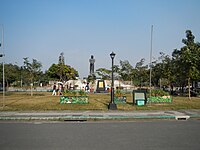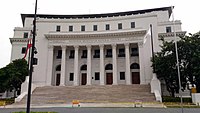Agrifina Circle
| Agrifina Circle | |
|---|---|
| Teodoro F. Valencia Circle (official) | |
 | |
 | |
| Location | |
| Rizal Park, Ermita, Manila, Philippines | |
| Roads at junction | General Luna Street Minor roads inside Rizal Park |
| Construction | |
| Type | Traffic circle |
| Maintained by | Department of Public Works and Highways - South Manila District Engineering Office[1] |
The Agrifina Circle, officially the Teodoro F. Valencia Circle, is a traffic circle within the eastern portion of Rizal Park in Manila, the Philippines.[2]
Etymology
The name "Agrifina" is a portmanteau of the words "Agriculture" and "Finance" since two neoclassical buildings located on opposite ends of the circle formerly housed the Departments of Agriculture and Finance. The former building of the Department of Finance formerly housed the Department of Tourism until 2015, when the building was vacated to make way for the new National Museum of Natural History.
The circle was officially renamed to Teodoro F. Valencia Circle on January 5, 1990 through Republic Act No. 6836,[3] after the longtime head of the park who initiated and maintained the park's beautification.[4]
History
The Agrifina Circle was intended to be a grand civic plaza surrounded by the planned Capitol Building and five wedge-shaped buildings which included the Finance and Agriculture Buildings, according to the Burnham Plan of Manila by American architect Daniel Burnham.[5]
After World War II, when it was decided that the capital of the Philippines was to be moved to Quezon City, the then-plaza was converted into a roundabout. Vehicular traffic was allowed in road until the late 1960s when Rizal Park was consolidated and most roads going through the park were pedestrianized. A globe fountain and skating rink was installed at the central island.[6]
There were plans to construct Luneta Tower, a 390-meter (1,280 ft) observation tower, at the Agrifina Circle for the Centennial celebration of Philippine Independence in 1998. The decision to build the tower at the site, however, was controversial and the plan was eventually shelved.
In 1998, the Binhi ng Kalayaan Monument replaced the fountain but the skating rink remained.[2] The monument was later moved to a barren area of Rizal Park in 2004 and was replaced by Sentinel of Freedom, a monument dedicated to Lapulapu.
Layout
| Eastern side | ||||
| Taft Avenue | ||||
| Binhi ng Kalayaan Garden |
* |  Relief map of the Philippines |
* |  Children's Park |
| Road | Agrifina Circle | General Luna Street | ||
 National Museum of Anthropology |
 Sentinel of Freedom |
 National Museum of Natural History | ||
| Road | Agrifina Circle | Road | ||
 Orchidarium |
* | Bisig Marker |
* | National Parks Development Committee Compound |
| Maria Y. Orosa Street | ||||
| Rest of Rizal Park | ||||
| Western side | ||||
| Note: (*) Footpath | ||||
References
- ^ "Road and Bridge Inventory". Department of Public Works and Highways. Retrieved July 20, 2022.
- ^ a b Aning, Jerome; Rivera, Blanche (May 7, 2000). "Blast rocks Rizal Park". Philippine Daily Inquirer. Retrieved July 29, 2016.
- ^ Republic Act No. 6836 (January 5, 1990), An Act Changing the Name of the Agrifina Circle, a Circular Road Near the Luneta Park in the City of Manila, to Teodoro F. Valencia Circle, retrieved July 29, 2016
- ^ Aning, Jerome (January 1, 2012). "Vatican City can fit in Rizal Park". Inquirer.net. Retrieved June 18, 2022.
- ^ "The Evolution of Manila". Malacañan Palace Presidential Museum and Library. Retrieved February 8, 2022.
- ^ Alcazaren, Paulo (July 14, 2001). "Rotundas: Circles of urban life". City Sense. The Philippine Star. Retrieved July 29, 2016.

